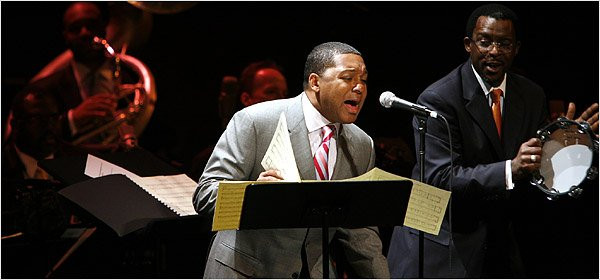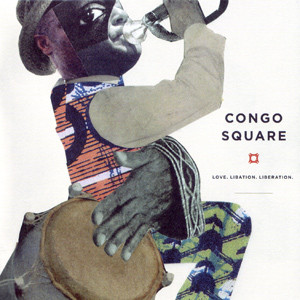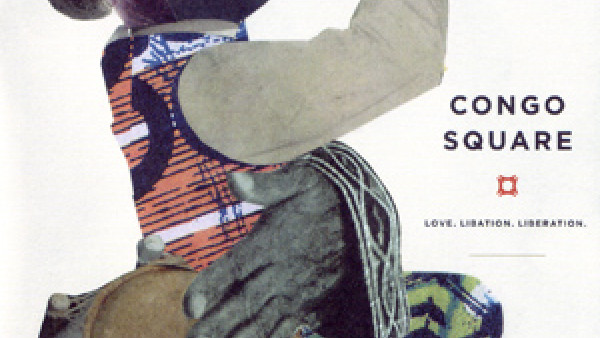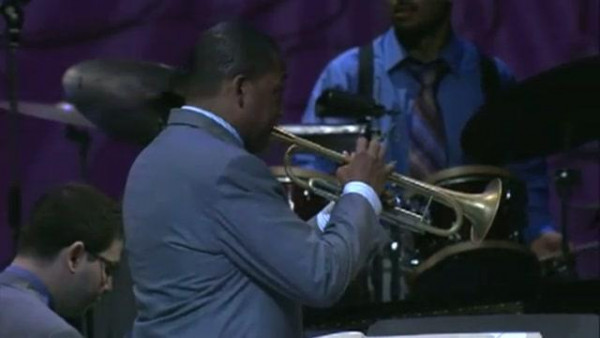Marsalis’s ‘Congo Square,’ With the Lincoln Center Orchestra

Wynton Marsalis at the microphone, with Herlin Riley on tambourine. (Credit Richard Termine for The New York Times)
Wynton Marsalis has composed a number of extended works during his tenure as artistic director of Jazz at Lincoln Center, usually with the stated ambition of capturing some aspect of the African-American experience. On Thursday night at the Rose Theater, he conducted his latest such effort, “Congo Square,” featuring the Lincoln Center Jazz Orchestra and Odadaa!, a nine-piece Ghanaian percussion and vocal troupe.
Mr. Marsalis, who has been recovering from a lip injury, didn’t touch the trumpet during his new commission (because he conceived his role as conductor only, according to Jazz at Lincoln Center). But even with solo flourishes entrusted to various members of the orchestra, individual exertions aren’t the focus of “Congo Square,” a tribute to the swatch of old New Orleans that functioned as a site of ancestral dancing and drumming for African slaves during the city’s French and Spanish occupations and well into the 19th century.
Last August, Mr. Marsalis announced plans to unveil his new work on location, at the historic site on the outer fringe of the French Quarter in what is now Louis Armstrong Park. Four days after the announcement, Hurricane Katrina hit the Gulf Coast. In the ensuing months Mr. Marsalis, the most recognizable living instrumentalist from New Orleans, engaged in a flurry of recovery efforts for the city.
In the same spirit, he expanded the plans for “Congo Square”: its premiere two weeks ago was a centerpiece of the annual French Quarter Festival. And it concluded a weeklong New Orleans residency by Mr. Marsalis and his organization, which then took the composition on the road before bringing it home this week.
The band’s recent time in New Orleans may have had something to do with the power of “Ring Shout,” the first of 14 movements in the suite. Its opening was the essence of simplicity: Herlin Riley walked onstage striking a tambourine. Then Mr. Marsalis leaned into a microphone to strike up a call and response with members of the orchestra.
Things quickly became topical. “Oh Lord, Katrina and the water flowed,” Mr. Marsalis sang, in an unpolished but soulful voice. “Folks got to cryin’ when the levee broke.” A later riff invoked the Federal Emergency Management Agency and the Red Cross, bemoaning deception and greed.
When the vocalizing ended, and the band kicked in, there was a sense of uplift and release. This was partly due to the arrangement, a glancing evocation of New Orleans brass bands; it was also due to Odadaa! and its polyrhythmic drive, illuminating the undercurrent of African rhythm in New Orleans second-line grooves.
Yacub Addy, the leader of Odadaa!, founded the group in the early 1980’s, after moving to the United States. But he has preserved the traditional sound of his native Ghana, which is what appealed to Mr. Marsalis; “Congo Square” is described as a collaborative product of both artists.
Their equal partnership was clear at choice moments: on a mambolike section called “Sunday Market,” during a churning “Place Congo” and in “Logo Talk,” which featured a steady cowbell pattern but an otherwise mercurial arrangement.
At other times, the two ensembles functioned independently. This was occasionally intentional and effective — Odadaa! could be entrancing on its own, especially during vocal exchanges led by Obuamah Laud Addy — but it was often because things just didn’t click.
Mr. Marsalis still takes compositional cues from Duke Ellington: there were bursts of brass, sweeping reeds and intricate internal harmonies. But there were also a few experiments in timbre, involving flutes, clarinets and muted horns. The orchestra was invariably up to the task.
What was missing, notwithstanding a saccharine ballad sung by Imani Gonzalez of Odadaa!, was a strong melody. That deficiency became more of a liability as “Congo Square” approached and passed the two-hour mark. The suite could be trimmed significantly and still pack a serious punch. But even then it might feel less than suitelike: a patchwork rather than a fabric.
by Nate Chinen
Source: The New York Times




Comments
Greetings!
The comments posted are all well received. Tapestry, pathchwork, or mosiac do not give justice to the dramatic and innovative elements of Congo Square. The cultural signifigance is the most important component that should be celebrated. Wynton has made it his mission to retell or speak for the lives of African slaves; America’s earliest displaced citizens of New Orleans. In other articles, Marsalis and Addy both spoke to the difficulties they experienced weaving the horn and drum sections together. Wynton further stressed the need in one article that the composition needed to be shorter.
Mr. Chenin comments are comments that people have expressed before. Some believe that Wynton’s music lacks emotion. Mr. Chenin commented directly to his ” sweeping ” movements of being Ellington-esque, as to say, “here we go again!” So he is basically saying, “why is this guy so great?”
Mr. Chenin knows why Wynton is great! Wynton is great because he is a teacher first. Wynton is a fundamental teacher of a genre to whom many have lost interest.
I am sure Mr. Chenin will be one of the first to congratulate Wynton and Addy come Grammy night! We all hate it when we are wrong.
Danielle on May 9th, 2006 at 2:52pm
Jurzy and Gloria,
Thank you for your “reviews” of Congo Square. After reading the NY Times piece, I was a bit put off by the negative undertone of the article, as if the critic were reaching to find fault with the piece. (Why doesn’t Ben Ratliff review Wynton’s work anymore? I appreciated his approach to Wynton’s work than the current critic Nate Chenin. I could only imagine the impact of this piece on its listeners when one considers the inspiration and story behind it. I would definitely love to hear this piece and hope it becomes a recording.
Sonalii
Sonalii on May 9th, 2006 at 10:15am
I agree, J!! Don’t worry, you know how critics are! I’ve yet to hear one compose music or play a musical instrument with genuine facility! So why listen to them? We can hear the music and decide for ourselves without their “help.”
A tapestry of merging cultures is what Congo Square represented and what this new work represents. Also thought it was made clear from the composition how
jazz and blues directly developed from African drumming; an amazing feat to relay this message to a Congo Square audience of 2006! This was the best I’ve heard from LCJO and Wynton Marsalis. Every solo strong and the merger
of bands was nothing less than astonishing. Sat. nite performance in NYC was recorded live; can we hear any
of it soon, Luigi? There seemed to be unlimited nuances, rhythms, melodies, riffs and motifs in contrasting moods and flavors. G.
gloria on May 9th, 2006 at 7:30am
I don’t mean to confuse myself/anyone else…I think Chinen’s idea of “patchwork” misses the historical point of Congo Square. When I use Chinen’s idea of “patchwork” I mean to illiminate the value of Congo Square as a “pactchwork” rather than detract from it as I think Chinen does. I find his term useful (but not the best, yet I have no beter term right now) but think it belies the fact that patchworks are complete and that their “seams” are a necessary part of recognizing the beauty of the fabric.
JG
Jurzy Girl on May 8th, 2006 at 9:23am
While I am still fussy with Nate Chinen over his review of Wynton w/strings, I appreciate fully his write up of Congo Square.
“Individual exertions were not the focus” of the work as Chinen states. Any vision of music designed to illuminate the historical and cultural events of Congo Square can only be conceived accurately as a group endeavor. As so many forum participants have stated, there were brilliant solos by various LCJO members; Wynton’s horn, while missed by some, was never a drawback of Congo Square. Indeed, in the history of the now legendary geographical setting, group synthesis was still strong; individual forays of the legal, social and musical sort were a thing of the future.
The “mambo like” section, Sunday Market was brilliantly executed. As I recall, there were also other sections of the work that revealed the multiplicity of cultures that converged in Congo Square. Again, historially accurate and a musical tribute the significane of the site but also a reality shaped by the undeniable, progressive polyrhytms of Africa and its associated diaspora.
A “saccharine ballad” by Imani Gonzalez?” What the hell? Grrrrr!!!
But Mr. Chinen’s comment that Congo Square is more a “patchwork than a fabric” is on point. I don’t agree but I think this a fair assesment of the work. I think Congo Square is the best long piece I know of Wynton’s; it demonstrates artistic maturity and Wynton’s continued evolution. There is also a depth of emotion in this work that I think is often missing in his work (unfortunately we can thank Katrina for this). However, I think the various transitions were relatively smooth in the context of the cultural and historical tension that existed at teh time. Re-membering (actually putting together peices to make sense of a whole) the moment accurately must necessarily acknowledge the legal and social tensions of the time. Slaves legal mobility was restricted, they congregated at great risk. Additonally, they were NOT a cohesive “fabirc” of people, there was great diversity in the cultures they represented. Hailing from various African countries, diasporic locations (the Sunday Market section Chinen notes is but one example of this in the work), and varied points within what became the US the music slaves must have created could not have been a cohesive “fabric” composed of a metaphorical single color. Yes, Mr. Chinen, a “patchwork” indeed…THAT’s the point. It is also the point that Wynton’s artistic vision (historic visions have this tendancy) forms the synthesis–it is conceived individually. I think Congo Square is his best extended work to date.
I rarely have “two cents” to contribute…this is my “nickle”!
JG
Jurzy Girl on May 8th, 2006 at 6:38am